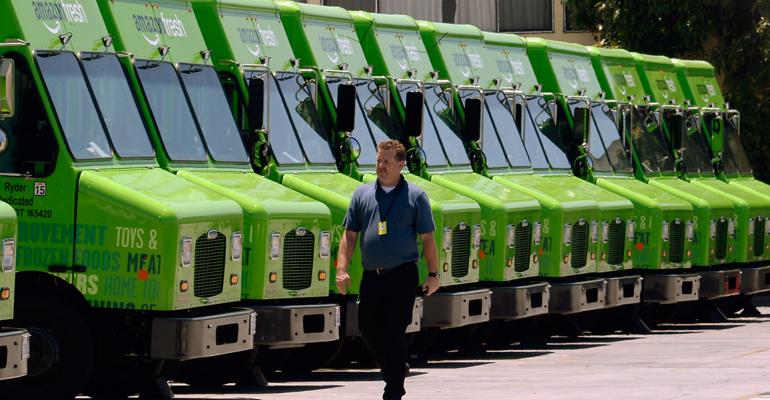There’s no denying that retailers are getting more confident in the online grocery space.
“Grocers are increasingly addressing the online format like they have a right to compete,” according to Jacqueline Martinez, partner in the consultancy Oliver Wyman. “This is good because grocers have a lot of assets and knowledge that pure-play operators don’t.”
 Central to this growing confidence has been click-and-collect, with Kroger, Walmart and smaller retailers embracing this strategy. It’s a differentiator because Amazon can’t do this with fresh grocery, at least at this point, Martinez emphasized.
Central to this growing confidence has been click-and-collect, with Kroger, Walmart and smaller retailers embracing this strategy. It’s a differentiator because Amazon can’t do this with fresh grocery, at least at this point, Martinez emphasized.
However, as online shopping gradually becomes a bigger piece of the pie, and supermarkets and other food retailers hone their models, Amazon remains the 800-pound gorilla.
Manufacturers are also mulling how to address Amazon. That was the subject of a recent content piece called “How CPG Companies Win with Amazon,” produced by Grocery Manufacturers Association and The Boston Consulting Group.
SN’s annual list of online shopping leaders shows Amazon out front, with approximately $2.1 billion in sales. That’s considerably ahead of Kroger and Peapod, the next biggest players, which each post about $650 million in sales online.
Amazon’s dominance may be understated, based on information from a recent report by Brick Meets Click.
Amazon attracts 48% of all online grocery trips, the report states. Its share of spending already matches that of multichannel supermarkets, at 32%. And its share of grocery trips rises considerably as households increase their number of monthly online trips. This is true even with AmazonFresh in limited rollout.

So how should retailers play such a formidable competitor? By not viewing it as a single competitor. Amazon has multiple platforms and each requires a different battle response, said Bill Bishop, chief architect, Brick Meets Click.
First, you need to figure out which Amazon platforms your own customers are using, and they just might tell you if you ask. Then, implement the right counter strategies, he explained.
Here’s a guide from Bishop on five Amazon platforms and suggested strategies for competing with each one:
1-AmazonFresh: This is the major food offering, but it hasn’t been rolled out widely yet. Amazon is still figuring out fresh. Retailers competing with AmazonFresh should emphasize the quality of their stores’ fresh foods.
2-Amazon Prime: Bishop hasn’t seen Prime as a powerful way to penetrate grocery business. It’s more like a default that has “already paid for shipping, so it’s a slow-ticking threat,” he said. Competing with Prime involves building an effective special order capability in the store, that hopefully would also be available online to customers for store pickup.
3-Prime Now: This service emphasizes quick, on-demand deliveries. It’s all about immediate consumption or craving. Competitors to Prime Now should “think of themselves as alternatives to Panera or pizza delivery,” Bishop advised. That means adopting some menu discipline from restaurants, making consumers more aware of the offerings, and possibly contracting for delivery.
4-Prime Pantry: This online offering allows users to fill a box with grocery items and have it delivered, saving shopping time. Supermarkets vying to compete should consider how to make center store shopping faster and more convenient, Bishop said. One way is by using navigation apps.
5-Amazon Subscribe and Save: This service allows users to set up regular, automatic re-orders of frequently used products. Bishop suggested that retailers explore various third party subscription services entering the market, and also look to the future replenishment potential of the Internet of Things.
I would urge retailers to take a close look at Bishop’s recommendations because they have a lot of merit. At a time when supermarkets may be feeling more confident in the online space, they need to fine-tune strategies to boost their firepower.
| Suggested Categories | More from Supermarket News |
 |
|
 |
|





